It seems like ten forevers since I’ve shared an embroidery project progress report with you!
But today’s your lucky day! Not only do you get a project update, but you’ll also get couple tips that will speed up your stitching process and that will save your sore little fingers.
The project here is Modern Crewel, a surface embroidery project worked in a variety of cotton threads with some bead embellishment. You can find my review of the embroidery kit here, if you’d like to know more about it.
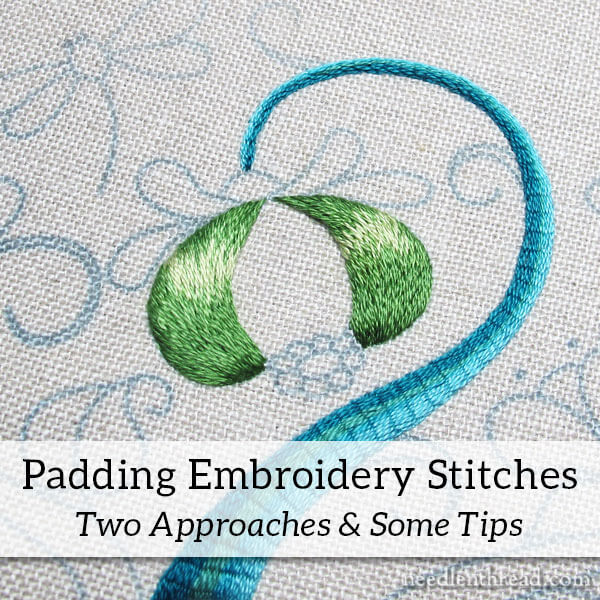
The last time we visited Modern Crewel, I had just finished the trunk, which is worked in raised stem stitch. You can read about that segment of the project and some tips here.
If I were following the instructions for the project carefully, my next step would be the other two trunks in the design. Instead, I decided to jump straight to the central element of the design – the pomegranate.
Padding Approach #1
The sides of the pomegranate, as you can see from the images of the design, are worked in long and short stitch shading.
To give the sides of the fruit a little lift, each side is embroidered with layers of padding stitches before the final layer of long and short is embroidered on top.
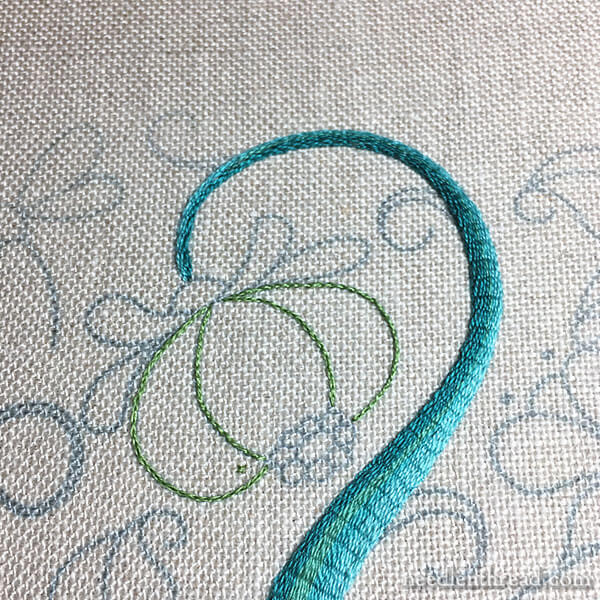
I started by outlining the areas to be filled in split stitch. A fine split stitch outline underneath a long and short stitch element helps define the edge, and it helps the stitcher keep the edge nice and smooth.
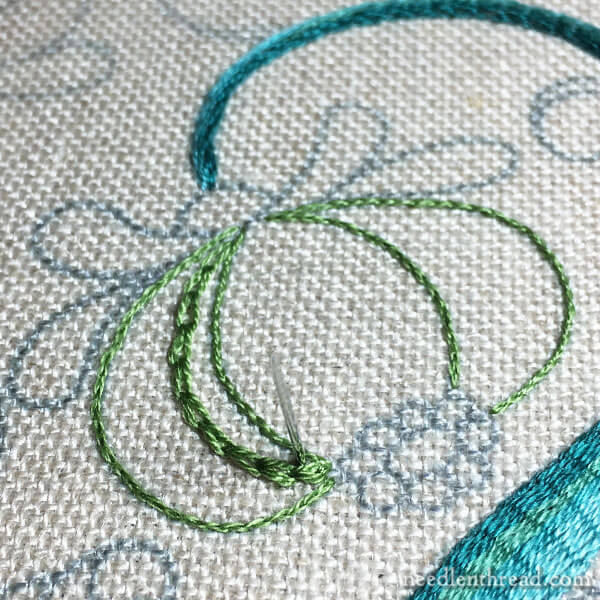
From there, it’s a matter of filling the center of the element with padding stitches. In this case, the instructions called for four layers of chain stitch padding using two strands of floss, working each layer perpendicular to the layer before.
When padding with layers of stitches, you want to make sure the final layer of padding is perpendicular to the direction of the top, covering layer of long & short stitch.
Incidentally, stem stitch, split stitch, chain stitch, and even just layers of straight stitches worked randomly to fill the area can all be used for padding. The structure of the chain stitch seems to add a little bulk as the layers are built.
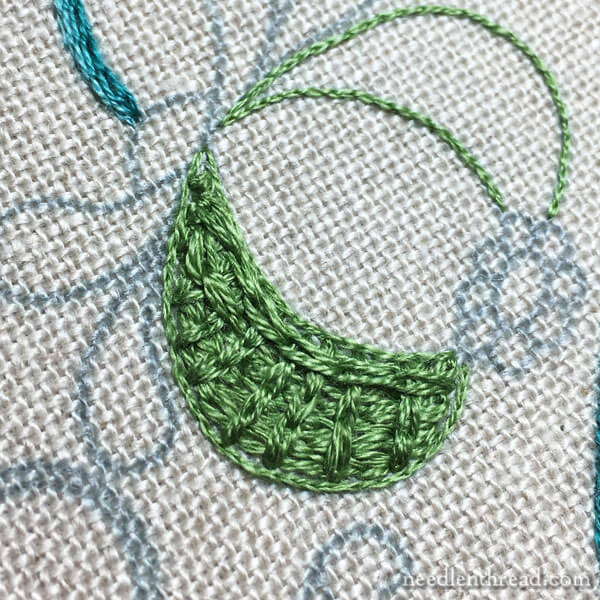
You can see here the third layer of chain stitch going in. The second layer (perpendicular to the first and the third), I spaced out slightly. As I looked ahead to the fourth layer of padding, I couldn’t help thinking, “Gosh, that’s a lot of dense stitching built up there.”
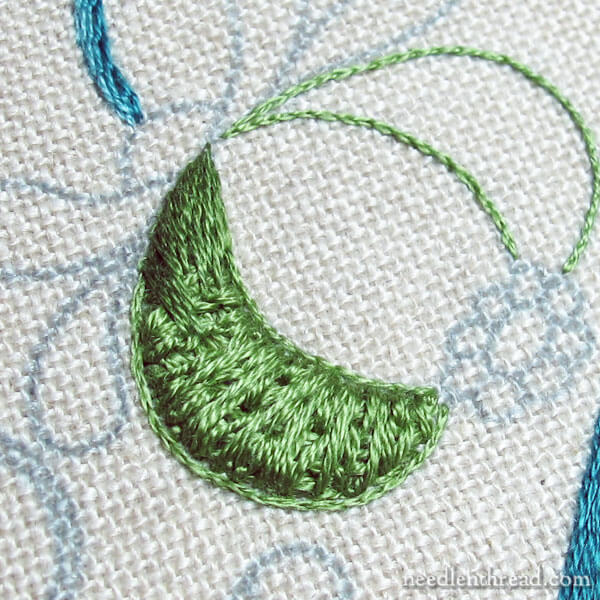
With the fourth layer of chain stitch padding, I ended up working the chain stitch lines a little farther apart, and then, to ensure that there wouldn’t be any noticeable dents in the surface, I filled between the short chain stitch rows with long straight stitches.
At this point, it really didn’t matter what stitch was used – I probably should have followed my instincts and worked straight satin stitches for that last layer of padding.
In any case, it was done, and on to the long and short stitch!
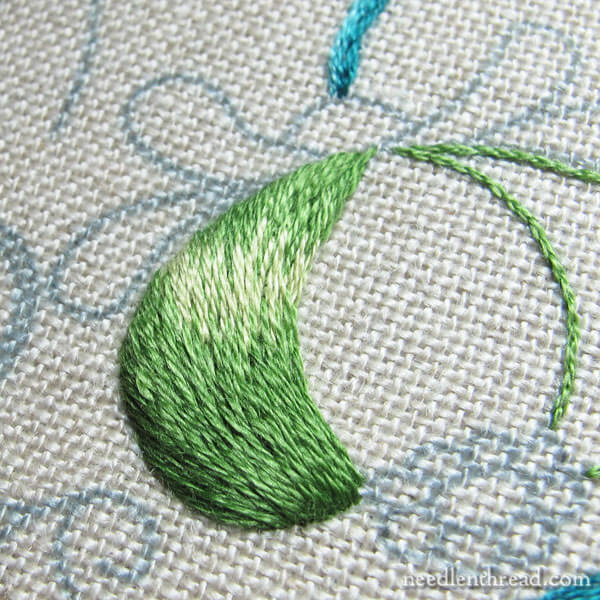
Using the smallest needle in the kit and one strand of floss, I worked the long and short stitch layer over all the padding.
It came out ok, but…
…golly. It was a pain to stitch!
The layers of padding increase the density of stuff in a relatively tiny space, and the poor needle has to pass through all of it, working against that density.
Needle Go Small!
Once I realized that it was going to be a laborious undertaking to work through those layers, I scrounged for the tiniest embroidery needle in my pincushion. I found a #11 – very tiny – that can accommodate one strand of floss.
Using a smaller needle when passing through densely populated stitched areas makes a huge difference in the ease with which the needle goes through the bulk. The larger the needle you use when trying to stitch through anything densely packed with stitches, the harder it is to get the needle through.
So switching to a tiny needle made it easier to stitch over this whole area with long & short stitch. It wasn’t perfectly easy, but it was easier.
Once that side was finished, I was ready to move on to the second side of the fruit.
Sort of.
My fingers were a little hesitant.
And really, I thought. Do I want to take the time to work up all those layers of chain stitch padding?
I answered myself: No.
Padding Approach #2: Same Height, Different Padding
At this point, I could have done two things: I could have changed the stitches used for the padding to long straight stitches. The lack of chain stitch structure would ease the density of the filled area a little bit, anyway.
Or I could change the padding approach entirely.
I chose the latter.
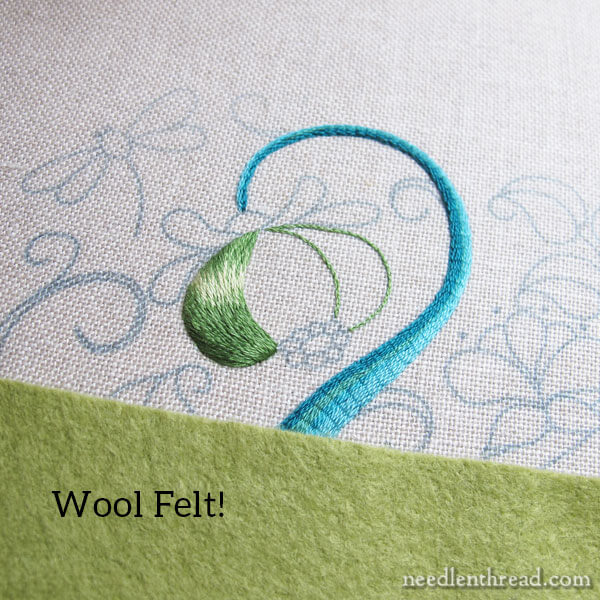
The kit already uses wool felt for padding in the hillocks at the base of the design. It’s a different color wool felt, and it wouldn’t really work under the pomegranate sides, but it just so happens that I have a fair collection of wool felt scraps.
I knew I just needed a tiny piece to fill the area, and I found a green that was close enough to do the trick.
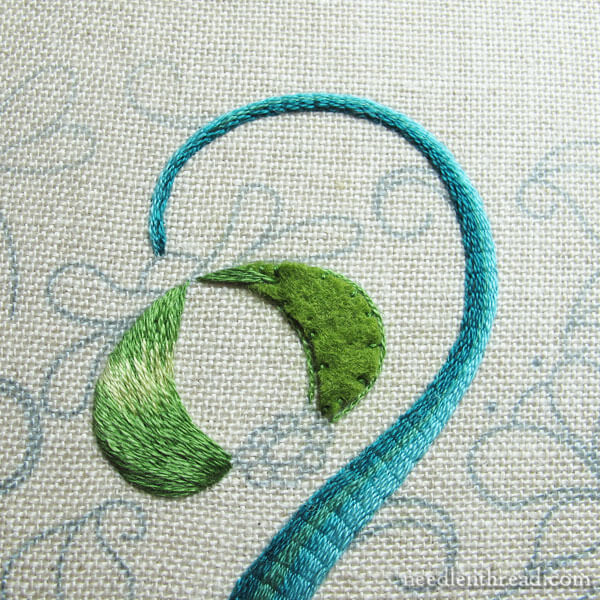
After trimming up a tiny crescent of wool felt that would fit inside the split stitch outline on the pomegranate side, I tacked it down on all sides using a matching color of floss, and then I started the long and short stitch right over the wool felt.
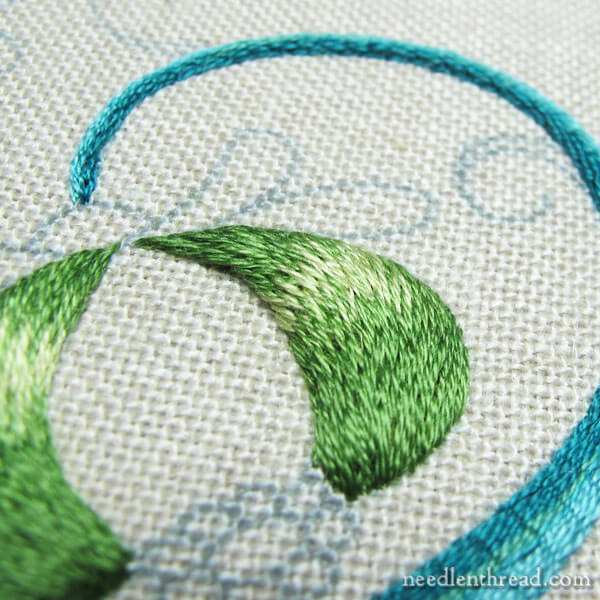
It took considerably less time to prepare the area for the long and short stitch (I didn’t have to embroider four layers of padding), it was much easier on the fingers when it came to stitching through the padding, and I think the finish, overall, was much nicer.
The height is no different between the two sides – or if it is, it isn’t noticeable to the naked eye. The both look sufficiently raised.
To Sum Up
When padding an area of embroidery, to avoid dense padding that’s difficult to stitch through, try these approaches:
1. Try long straight stitches rather than chain stitch or other stitches with a more complex structure.
2. If it makes sense to do so (with the design you’re stitching), substitute wool felt for padding stitches.
3. Use the smallest needle possible when stitching through heavier padding. It’s much easier to pull smaller needles through dense areas.
If you’re undertaking any padded embroidery any time soon, I hope you find these tips handy!
Other Articles on This Project
If you’d like to know more about this project or catch up on it, here are the previous articles:
Setting Up Modern Crewel for Stitching (including transfer tips)
Raised Stem Stitch on the Trunk







Gosh, that was absolutely fascinating. It is so useful to have your meticulous step by step explanations, and the comparison of the different techniques. Thank you so much, Mary.
Dear Mary,
Thank you, again, for amazing me with you wealth of information about embroidery. I am someone who has to “follow the rules” or, in this case, the directions. I have seen you take apart the one church piece and you showed what the padding that was used. I think that this is the first time, for me, to see how felt or other padding could be used. Thank you for all you the knowledge you share with us here.
Of course, I do hope you are doing well.
Nick Pericone
While both techniques look good, I think the first looks better. The long and short stitches over the chain stitch padding blend better. It looks more like thread painting when compared to the other, because the ends of the stitches over the wool can be seen more clearly. This, of course, may be due to the photo, angle of light, etc.
This was very helpful. Padding I have done, and it’s not much, has been with split stitch layers. Using wool felt is brilliant.
Thank you Mary! That was perfectly timed for me. I just finished doing a mediocre job of padding a little area I was stitching. I think the lessons are especially helpful to me when I’ve just been wrestling with the issue at hand.
If I haven’t done it yet, it all just looks simple and obvious (and easy, did I mention easy?) but when I’ve been working on it a bit, then I know what little things to look for.
So helpful! Thanks Mary — love watching your work on this project.
Mary, that was marvelous! Where do you order WOOL felt? The stores here are quilting, almost exclusively except for Joann’s and they don’t carry it. I notice you set up the project on Evertite frames that I use for needlepoint. When setting up the Mellerstain kit, you were putting it on a hoop. How did you make that decision for each project. Is it size? I was rather expecting you to do the firescreen on slate frames. Thanks, Mary.
Wooly Thread! http://www.woolythread.com
Dear Mary
The padding of the first side of the pomegranate looks so complicated all that stitching involved for the padding is a lot of work. I really prefer the felt option and I agree with you that using the felt is a much easier way to lift the embroidery before adding the long and short stitch. I will be starting a new project soon involving the long and short stitch and after your post today I think I will use padding to raise the embroidery. I’m embroidering a Poppy that will be made in to a small pillow so this post has been very useful. Thanks for sharing your tips and techniques on padded long and short stitch and for sharing your view on how to save time on stitching.
Regards Anita Simmance
Love the idea using wool felt for padding! Question-if one doesn’t have wool felt, is regular craft felt ok to use? Thank you for the informative article.
I’ve done the padding both ways, and I have to admit the felt is so much easier. In my last project, I did all the padding with split stitch in cotton floss, so as not to use up the silk from the kit. I’ll have to build up a nice collection of felt so I can switch to using it.
Hi Mary, I was reading along as you were stitching the four layers of stitches and wondering why didn’t you just pad it with felt and you did! You can use multiple layers depending on how much of a raised effect you want: start by tacking the smallest piece first and finish with the largest piece. The one thing I would have done differently is that I tack the largest layer with just a few stitches and then I Blanket Stitch around the edge; the Blanket Stitch helps hold all the edges down while I’m stitching over the felt.
I love seeing common sense triumph over impractical theory. Congratulations on your willingness to trust your intuition and experience! Great way to start the new year!
Hurray for intuition. I was unhappy with a previous padded stitch and came up with using wool felt as well. I didn’t have the exact color I needed (and yes, I only use REAL wool felt). So I came up with this:
The process I use requires:
–old glass quart jars, (Canning Jars or Pyrex measuring cup)
–distilled vinegar
–water
–four color box of food coloring the kind you use for Easter eggs
–piece of felt.
Fill the glass jars 1/2 to 2/3 full of warm water. Add 2 T distilled vinegar to each quart jar. Now take the bottle of liquid food coloring and add drops of color in the jars of water until the water is very dark or just experiment. I usually figure at least 10 drops of color to a jar. The drops do not have to be all the same color and there is no limit to the combinations possible. Pre-soak the felt to be dyed in warm water. In a modern microwave cook for 3 minutes. Up to 6 in an older one. You want the water to boil.
Take it out and let it cool. The wool should absorb all of the dye. Rinse and let dry. Since it’s food grade food coloring, you can use your regular microwave. No microwave? you can do this in a canning kettle. So now I only have to purchase white felt and can get the color I need. Sometimes I have to dye twice to get the right color. (Rayon felt cannot be dyed the same way). Remember NOT to precut your piece exactly as many felts will shrink a bit after this process. I tend to trim after the felting process. On Etsy search for 100% wool felt. I’ve used FeltontheFly.
I save my scraps from wool sewing and felt them in the washer and dryer to use. They are fulled wool/not felted wool (true felt is not woven), but they work well for this same type of work.
You mentioned sore fingers with the stitched padding – Thimbles! They really cut down on the pain. Access Commodities has some that come in whole and half sizes so they fit properly and are open to permit long nails.
Thank you, Mary! The felt would also avoid the problem of lumps and bumps from uneven padding stitches (because not all of us stitch perfectly!). I like Celeste’s idea of blanket stitches around the edges for extra neatness. Both sides of the pomegranate look good to me, and the trunk is looking gorgeous, too.
Mary,
Thank-you for the padding tip. I think both ways look great, but I think I’ll try the padding with the felt first. I have never done any crewel work and My project it for a beginner. I really appreciate your web sight, I have learned a lot.
Hope You are doing good,
Happy stitching,
Louann P
Hi Mary,
Thank you so much for all your thoughts on this, they will be a great help when I get back to my project. I actually started this in a 2 day workshop with Susan Porter who was a blast ggg I am trying to decide whether to put this on my UFO list for this year or not! I have such a long list of them!
Thanks for the help.
Cheers Judy
SE Queensland, Australia
who must get back to the job of putting away all my Christmas decorations!
Hi Mary, thanks for this tip! When I look at both sides of the work, the felt side looks more uniform to me, more tidy and smooth. The first side, padded with stitches, looks a wee tiny bit floofy, is the only word I can come up with, as compared to the felt side. I had forgotten about using felt for padding, you are the one who taught me that years ago! Happy New Year!
Hello Mary,
I know my comment isn’t related to this post, and I’m sorry for that, but I turned to you thinking that you might be able to help me. Long story short: I started embroidering after a long break; my first tiny project was a blue tit, cross stitched on evenweave. I’d like to make it into a bird-shaped ornament and, well, I don’t know how to! I don’t know how to cut the fabric, nor how to sew it. Could you please point me to some trustable tutorial?
Thank you!
Mary…I am stitching this same project with you! I must admit, I did finish all three trunks. I had never encountered the detached stem stitch before and when I finished the first trunk I just kept going! I also finished the curling tendrils. Because I usually follow the directions step by step…the leaves are up next and the directions are to use chain stitch padding. I have never done that so I decided to wait for you!
Today I read your post. Imagine my surprise when you skipped the specific steps in the directions and jumped right to doing the pomegranate! I guess I never thought of giving myself permission to jump around the directions…and enjoyed the fact that you did it!
And then, you demonstrated the chain stitch padding in the pomegranate…and then using felt! The chain stitch padding was a bit confusing to me, but wow…the felt looks great and is something that I have previously done…and successfully!
I look forward to your next steps…as I will follow your path through this project. And I wonder if you will use the chain stitch padding or the felt to complete the leaves…which are much smaller than the sides of the pomegranate! I can’t wait to find out!
Whoops…sorry, Mary! I mispoke in the above message!
I went back to your original message from last month about this project and I read that you were planning on going from completing one trunk directly to doing the pomegranate! You admitted that you were going to complete this project “out of order” and I just missed it! Or, I had one of those “senior moments” yesterday when I read this second posting and I just “forgot” what you said originally! I got excited that you were jumping around the pattern…I never thought I could do that…and that was an epiphany to me!!
So, today I found my variety pack of felt from the “Wooly Thread” and will start my pomegranate soon! Thanks for your directions and encouragement!
So interesting Mary. Thank you. As I was reading I was sitting there wondering “would felt work, and be quicker and easier”? LOL, you answered my question. I had tried it in the past, on the first piece I did but layered it with 3-4 layers which became difficult to stitch thru too. I am now just finishing up a piece that I wanted to add a 3-D “bush” in the front corner. Managed it, but not thrilled. I will have to come up with something a bit more workable, as what I did was terribly difficult to do and I didn’t achieve what I was envisioning. I embroidered on water soluble “fabric” but it tore, didn’t work as I’d hoped and I couldn’t do what I really wanted to do. So, more experimentation needed. 🙂 These posts on this type thing are so helpful to me doing what I have been doing, thank you so much for your expertise.
I’ve commented plenty of times before, Mary, but I don’t think I ever stopped to tell you how much I appreciate the really big, close-up, detailed photos. Besides being endlessly helpful, they’re pretty and I just enjoy them!
Good morning; your crewel work is spectacular! Two questions:
Is this a kit that can be purchased?
Do you know where I can get #11 needles?
Thank you,
Janet
Hello Mary, Can you share a source for the wool felt? Or, maybe I missed that detail in an earlier post. Thanks so much, Jeanne
Hi, Jeanne – Wooly Thread carries a nice variety of colors of wool felt: Wooly Thread wool felt variety pack. If you scroll down on that page, you’ll find a variety pack of small pieces.
I have used cheap polyester felt from Walmart for padding with good results. Is there a reason you use expensive wool felt?
Yes. It’s much, much nicer than sewing on acrylic / polyester felt. I prefer the density of the fibers, the smooth hand, and the lack of frustration when sewing it down. Craft felt tends to have fuzzy edges, and when trying to sew it precisely on a close edge, the fibers have a tendency to thin and separate. I like the sharp, precise edges you can achieve with good quality wool felt when cutting it. And when it is visible, I very much prefer the look of it over craft felt.
So glad your past posts are still available, Ms. Corbet!! Many thanks for all of them, and for enhancing the learning process!!